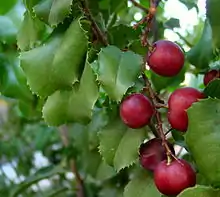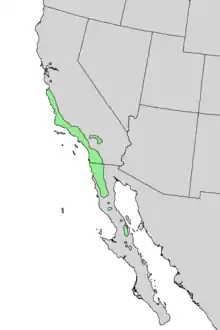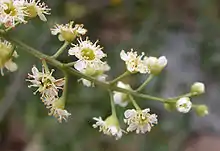Prunus ilicifolia
Prunus ilicifolia (Common names: hollyleaf cherry,[3] evergreen cherry;[4] islay - Salinan Native American[5]) is native to the chaparral areas of coastal California (from Mendocino County to San Diego County), Baja California, and Baja California Sur.[4][6] as well as the desert chaparral areas of the Mojave desert.[7][8] Despite its name, it is not a true cherry (P. subg. Cerasus) species. It is traditionally included in P. subg. Laurocerasus, but molecular research indicates it is nested with species of P. subg. Padus.[9]
| Prunus ilicifolia | |
|---|---|
 | |
| Scientific classification | |
| Kingdom: | Plantae |
| Clade: | Tracheophytes |
| Clade: | Angiosperms |
| Clade: | Eudicots |
| Clade: | Rosids |
| Order: | Rosales |
| Family: | Rosaceae |
| Genus: | Prunus |
| Species: | P. ilicifolia |
| Binomial name | |
| Prunus ilicifolia | |
 | |
| Natural range of Prunus ilicifolia (var. ilicifolia green; var. occidentalis blue) | |
| Synonyms[1][2] | |
| |
Prunus ilicifolia is an evergreen shrub[3] to tree, producing edible cherries, with shiny and spiny toothed leaves[3] similar in appearance to those of holly. This resemblance is the source of both the common name "holly-leaved cherry" and the scientific epithet "ilicifolia" (Ilex-leaved). It grows 8 to 30 feet (240–900 cm) tall, with thick, alternate leaves 1 to 2 inches (2.5-5.0 cm) in length.[3] It has small white flowers growing in clusters, similar in appearance to most members of the rose family, Rosaceae, flowering from March to May.[3] The flowers are terminal on small stalks, with the youngest at the cluster center. The purple to black fruit is sweet, with a very thin pulp around a large single stone (drupe).[3][10]
The plant is prized for cultivation, showy and easily grown from seed, and has been cultivated for centuries as a food source, and tolerates twice yearly pruning when often used as a hedge.[3] The plant likes full sun, loose open soil (porous), and tolerates drought conditions well, but needs regular watering when young.[3] Bees are attracted to it.[3]
"Prunus" comes from the old Latin for "plum". "Ilici - folia means "holly like - leaves".[3] This is the only species of the genus Prunus native to the Santa Monica Mountains that divide the Los Angeles basin from the San Fernando Valley, California.[3]
Description

It is an evergreen shrub[3] or small tree approaching 15 meters (50 feet) in height,[11] with dense, hard leaves[3] (sclerophyllous foliage). The leaves are 1.6–12 cm (0.64-4.8 inches) long with a 4–25 mm (0.16-1.00 inch) petiole[11] and spiny margins, somewhat resembling those of the holly. The leaves are dark green when mature and generally shiny on top, and have a smell resembling almonds when crushed; these are poisonous to eat, but not to handle.[12] The flowers are small (1–5 mm), white, produced on racemes in the spring. The fruit is a cherry 12–25 mm diameter, edible[3] and sweet, but contains little flesh surrounding the smooth seed.[11][13][14]
Subspecies
There are two subspecies:[15][16][17]
- P. ilcifolia subsp. ilicifolia - mainland California and Baja California, red fruit 12–18 mm diameter
- P. ilicifolia subsp. lyonii (Eastw.) Raven - Catalina cherry, Channel Islands of California (San Clemente, Santa Catalina, Santa Cruz and Santa Rosa Island islands), blue-black fruit 15–25 mm diameter
Distribution, habitat, and ecology
Prunus ilicifolia is native to California chaparral and foothill woodlands along the Coast Ranges below 1,600 m.[11] Its distribution extends from northern Baja California along the California coast to the northernmost extent of the Coast Ranges,[11] as well as into the desert chaparral areas of the Mojave desert. In chaparral communities, it tends to inhabit north-facing slopes, erosion channels, or other moist, cool sites.[4]
It is a persistent member of chaparral communities, being slow-growing but long-lived; common chaparral flora associates are toyon, western poison-oak and coffeeberry.[18] In the absence of fire, P. ilicifolia will outlive or outshade surrounding vegetation, making room for seedlings. Eventually, it will form extensive stands codominated by scrub oak.[4]
Regeneration and seedlings
Although it will resprout from the stump after fires, the seeds are not fire-adapted like those of many other chaparral plants.[19] Instead, it relies on the natural death of surrounding vegetation during long periods of fire-free conditions to make room for its seedlings.[4]
The seeds are also reported to require sunlight to germinate.[19] However, near 100% germination rates have been achieved with wild-collected seed buried completely in pots with a peatlite mix.[20]
Butterflies
The caterpillars of the pale swallowtail (Papilio eurymedon) feed on this and other members of the riparian woodland plant community.[17] It is also a larval host to the California hairstreak, Lorquin's admiral, Nevada buckmoth, and tiger swallowtail.[21]
Cultivation
Prunus ilicifolia is used in California native plants and wildlife gardens, and drought-tolerant sustainable landscaping.
Uses
Native Americans fermented the fruit into an intoxicating drink.[3] Some also cracked the dried cherries and made meal from the seeds after grinding and leaching them.[22] It has also been made into jam.[23]
References
| Wikimedia Commons has media related to Prunus ilicifolia. |
- The Plant List, Cerasus ilicifolia Nutt. ex Hook. & Arn
- Tropicos, Prunus ilicifolia (Nutt. ex Hook. & Arn.) D. Dietr.
- Flowering Plants of the Santa Monica Mountains, Coastal & Chaparral Regions of Southern California, Nancy Dale, 1985, p172
- Fire Effects Information Service, USDA Forest Service: Prunus ilicifolia
- E.G. Gudde (1946). The Solution of the Islay Problem. California Folklore Quarterly 5 (3): 298-299 (Gudde concludes that the word "islay" originated in a Salinan word slay; Islay was the Spanish version of their word).
- "Prunus ilicifolia". Germplasm Resources Information Network (GRIN). Agricultural Research Service (ARS), United States Department of Agriculture (USDA). Retrieved 24 December 2017.
- Calflora taxon report, University of California, Prunus ilicifolia (Nutt.) Walp., Holly leaved Cherry, holly leaf cherry, hollyleaf cherry
- SEINet, Southwestern Biodiversity, Arizona chapter photos and distribution map
- Wen, Jun; Berggren, Scott T.; Lee, Chung-Hee; Ickert-Bond, Stefanie; Yi, Ting-Shuang; Yoo, Ki-Oug; Xie, Lei; Shaw, Joey; Potter, Dan (2008-04-25). "Phylogenetic inferences in Prunus (Rosaceae) using chloroplast ndhF and nuclear ribosomal ITS sequences". Journal of Systematics and Evolution. 46 (3): 322–332. doi:10.3724/SP.J.1002.2008.08065. ISSN 1674-4918.
- Jan Timbrook (December 1982). "Use of Wild Cherry Pits as Food by the California Indians" (PDF). Journal of Ethnobiology. Santa Barbara, California. 2 (2): 163. Retrieved 23 June 2019.
- Jepson Flora: Prunus ilicifolia
- Peattie, Donald Culross (1953). A Natural History of Western Trees. New York: Bonanza Books. p. 543.
- Munz, Philip A. 1973. A California flora and supplement. Berkeley, CA: University of California Press.
- Conrad, C. E. (1987). Common shrubs of chaparral and associated ecosystems of southern California. Gen. Tech. Rep. PSW-99. Berkeley, CA: U.S. Department of Agriculture, Forest Service, Pacific Southwest Forest and Range Experiment Station.
- Jepson Flora: Prunus ilicifolia subsp. ilicifolia
- Jepson Flora: Prunus ilicifolia subsp. lyonii
- Schoenherr, A. A. (1993). A Natural History of California. University of California Press, Berkeley.
- Hogan, C. Michael (2008) Toyon (Heteromeles arbutifolia), GlobalTwitcher, ed. N. Stromberg "Archived copy". Archived from the original on 2009-07-19. Retrieved 2009-08-19.CS1 maint: archived copy as title (link)
- Keeley, Jon E. 1987. Role of fire in seed germination of woody taxa in California chaparral. Ecology 68(2): 434-443; cited in FEIS
- Mirov, N. T., & Kraebel, C. J. (1937). Collecting and propagating the seeds of California wild plants. Research Note 18: 1-27. Berkeley, CA: U.S. Department of Agriculture, Forest Service, California Forest and Range Experiment Station
- The Xerces Society (2016), Gardening for Butterflies: How You Can Attract and Protect Beautiful, Beneficial Insects, Timber Press.
- Whitney, Stephen (1985). Western Forests (The Audubon Society Nature Guides). New York: Knopf. p. 417. ISBN 0-394-73127-1.
- Peattie, Donald Culross (1953). A Natural History of Western Trees. New York: Bonanza Books. p. 544.
External links
- Fourdir.com: High Desert Trees
- Desert-Tropicals: Hollyleaf Cherry (Prunus ilicifolia) access date March 26, 2010
